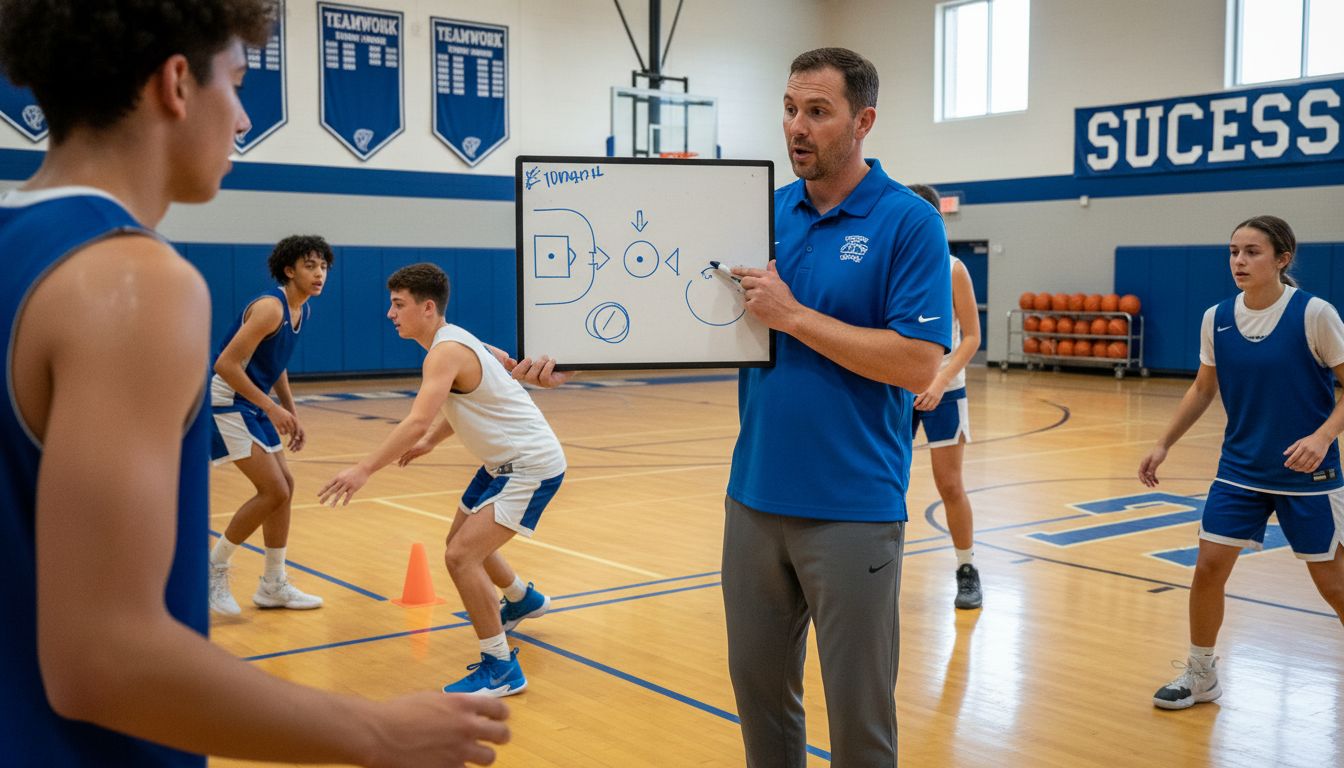Most teams underestimate how much true offensive flow shapes their success, yet research shows that data-driven analysis is challenging old coaching habits. Offensive flow goes far beyond passing and shooting—it blends timing, movement, and split-second choices that elevate every possession. Misconceptions often trip up even experienced coaches, but understanding the science and strategy behind offensive systems can spark smarter, more reliable scoring. This guide reveals what really drives an effective, adaptable offense in modern basketball.
Table of Contents
- Defining Basketball Offensive Flow and Misconceptions
- Types of Offensive Systems and Their Key Differences
- Core Principles Behind Effective Offensive Flow
- Essential Player Roles and Responsibilities
- Teaching, Implementing, and Troubleshooting Offensive Flow
Key Takeaways
| Point | Details |
|---|---|
| Offensive Flow is Complex | Effective basketball offense is a dynamic system requiring synchronized movement, strategic spacing, and intelligent decision-making rather than just individual player skills. |
| Types of Offensive Systems Differ | Teams must understand various offensive systems like motion and dribble drive to adapt their strategies to defensive configurations and maximize scoring opportunities. |
| Core Principles Are Key | Successful offensive flow relies on constant movement, intelligent spacing, and collective decision-making, transforming individual talents into cohesive team play. |
| Coaching Requires Adaptability | Implementing and troubleshooting offensive flow demands a focus on cognitive flexibility, non-verbal communication, and continuous adaptation to enhance team performance. |
Defining Basketball Offensive Flow and Misconceptions
Basketball offensive flow represents the dynamic movement and strategic coordination of players designed to create scoring opportunities. At its core, offensive flow is more than just ball movement - it’s a sophisticated system of player positioning, timing, and intelligent decision making that allows teams to consistently generate high-percentage shots.
Research from arxiv.org reveals that offensive flow can be scientifically analyzed through spatio-temporal data tracking, challenging traditional coaching assumptions. The ‘tHoops’ framework demonstrates how precise player movements and interactions create complex offensive patterns that go beyond simple play execution. This means coaches must think about offensive strategies as interconnected systems rather than isolated plays.
Common misconceptions about offensive flow often revolve around oversimplified views of player roles and movement. Many coaches incorrectly believe that offensive flow is solely determined by individual player skills. However, arxiv.org indicates that machine learning analysis of NBA player behavior reveals a much more nuanced reality. Successful offensive flow requires:
- Synchronized player movements
- Strategic spacing
- Anticipatory decision making
- Collective basketball intelligence
Understanding offensive flow means recognizing it as a complex, adaptive system where players must continuously read and react to defensive configurations. Basketball Offensive Concepts: A Modern Guide For Coaches provides deeper insights into these intricate team dynamics, helping coaches develop more sophisticated offensive strategies that transcend traditional play structures.
Types of Offensive Systems and Their Key Differences
Basketball offensive systems are strategic frameworks that define how teams approach scoring opportunities, each with unique principles and execution styles. Understanding these systems is crucial for coaches seeking to develop versatile and effective team strategies that can adapt to different defensive configurations and player strengths.
Wikipedia describes the motion offense as a highly flexible strategy emphasizing continuous player movement and spontaneous passing. Unlike rigid set plays, this system allows players to react dynamically to defensive alignments, creating unpredictable scoring opportunities. The core philosophy is player empowerment, where athletes read the court and make intelligent decisions based on real-time defensive positioning.
Another distinctive offensive system is the dribble drive motion offense, which Wikipedia notes focuses on spreading players to create driving lanes. This approach relies heavily on guard penetration, with players designed to either score directly or draw defensive attention and pass to open teammates. Key differences between offensive systems include:
- Motion Offense: Emphasizes fluid movement and collective decision-making
- Dribble Drive Motion: Prioritizes guard penetration and spacing
- Set Play Systems: Follow predetermined player movements
- Triangle Offense: Utilizes triangular player positioning for complex interactions
What Is Motion Offense In Basketball? provides coaches deeper insights into how these systems can be implemented, highlighting that successful offensive strategies are not about rigid rules but adaptive, intelligent team play. Coaches must carefully select and teach offensive systems that match their team’s specific skill set, athleticism, and basketball IQ.

Core Principles Behind Effective Offensive Flow
Offensive flow in basketball represents a complex interplay of strategic movement, player intelligence, and collective team dynamics. Successful teams understand that effective offense transcends individual skills and requires a holistic approach to creating scoring opportunities.
arXiv research revisiting Dean Oliver’s Four Factors reveals critical insights into offensive efficiency. These fundamental principles demonstrate that effective offensive flow depends on more than just raw athletic talent. The key factors include shooting efficiency, turnover minimization, offensive rebounding, and creating free throw opportunities. Coaches must design systems that optimize these elements, transforming individual player capabilities into a synchronized team performance.
Wikipedia highlights that motion offense principles provide a blueprint for achieving fluid offensive flow. The core tenets of this approach emphasize:
- Constant player movement
- Intelligent spacing
- Unselfish ball distribution
- Real-time defensive reading
- Collective decision-making
Mastering Basketball Motion Offense: Essential Guide For Coaches offers deeper insights into implementing these principles. Understanding offensive flow means recognizing that it’s a dynamic system where players must continuously adapt, communicate, and create opportunities through intelligent, coordinated actions. The most successful teams transform individual talents into a cohesive, unpredictable offensive machine that challenges defensive strategies at every moment.
Essential Player Roles and Responsibilities
Player roles are the foundational building blocks of any successful basketball offensive system. Understanding and executing specific responsibilities allows teams to transform individual talents into a cohesive, dynamic scoring machine that can adapt to various defensive challenges.
Wikipedia illustrates this principle through the Blocker-Mover offense, which clearly defines two critical player archetypes. Blockers are responsible for setting strategic screens, creating space and opportunities for movers who utilize these screens to generate scoring chances. This specialized role assignment demonstrates how precise player responsibilities directly contribute to offensive effectiveness.
Wikipedia further highlights the nuanced responsibilities in offensive systems, particularly in the dribble drive motion offense. In this approach, guards bear the primary responsibility for defensive penetration, while forwards and centers strategically position themselves to:
- Receive potential kickout passes
- Create rebounding opportunities
- Provide secondary scoring options
- Maintain defensive spacing
- Support guard penetration
The Role Of Team Captain In Basketball provides additional context on how individual player responsibilities extend beyond physical roles to include leadership and strategic communication. Successful teams recognize that effective offensive flow requires players to understand not just their technical responsibilities, but also their broader strategic and interpersonal roles within the team’s collective system.

Teaching, Implementing, and Troubleshooting Offensive Flow
Offensive flow is a complex system that requires deliberate, strategic coaching approaches to develop and maintain. Coaches must recognize that implementing an effective offensive strategy goes far beyond simple play diagrams and involves creating a dynamic, adaptive team mentality.
arXiv research modeling basketball games as dynamic networks reveals critical insights into player interactions that can transform coaching strategies. By understanding players as interconnected nodes within a complex system, coaches can design training protocols that emphasize communication, spatial awareness, and collective decision-making. This approach shifts the focus from rigid play execution to developing players’ ability to read and respond to defensive configurations in real-time.
Successful implementation of offensive flow requires a multifaceted approach. Coaches must focus on developing:
- Cognitive flexibility
- Non-verbal communication skills
- Situational awareness
- Collective basketball intelligence
- Adaptive decision-making
10 Essential Basketball Offense Techniques Every Player Should Master provides additional insights into technique development. Troubleshooting offensive flow involves identifying and addressing common breakdown points, such as predictable movement patterns, poor spacing, or inconsistent communication. The most effective coaches treat offensive flow as a living, breathing system that requires constant refinement, player education, and strategic adaptation.
Take Your Team’s Offensive Flow to the Next Level
Mastering basketball offensive flow means going beyond just individual skills. It requires clear strategies for synchronized movement, smart spacing, and real-time decision making. If you are aiming to break down complex offensive systems like the motion offense or dribble drive motion, and want to see your team implement them with confidence and precision, the challenge is real. You need resources that help you teach, practice, and troubleshoot these concepts efficiently while keeping players engaged and adaptable.

Discover our carefully crafted Basketball Playbooks - Hoop Mentality designed to bring your offensive concepts to life in game settings. Pair them with targeted Basketball Drills - Hoop Mentality that develop the exact player roles and team dynamics your system demands. Start building a team that reads defenses better, moves smarter, and scores more consistently. Visit Hoop Mentality now and get the tools that give you the edge in coaching offensive flow the right way.
Frequently Asked Questions
What is basketball offensive flow?
Basketball offensive flow refers to the dynamic movement and strategic coordination of players designed to create scoring opportunities through synchronized movements, strategic spacing, and anticipatory decision making.
How does the motion offense differ from other offensive systems?
The motion offense emphasizes continuous player movement and spontaneous passing, allowing players to react to defensive alignments, whereas other systems like set plays and dribble drive motion have more rigid structures and specific player roles.
What are the core principles behind effective offensive flow?
Effective offensive flow relies on constant player movement, intelligent spacing, unselfish ball distribution, real-time defensive reading, and collective decision-making to create high-percentage scoring opportunities.
How can coaches troubleshoot issues in offensive flow?
Coaches can troubleshoot offensive flow by identifying breakdown points such as predictable movement patterns, poor spacing, and inconsistent communication, and then implementing strategies to improve cognitive flexibility, situational awareness, and non-verbal communication skills.

